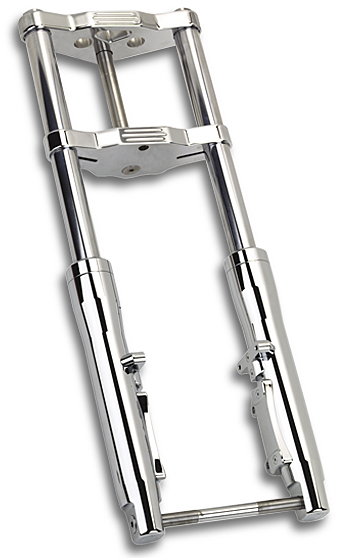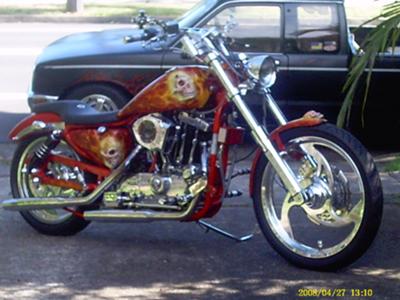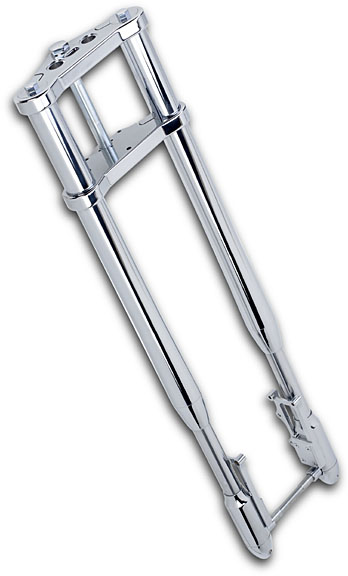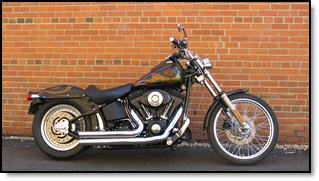A Basic Guide To Hydraulic Forks!
 Ultima forks.
Ultima forks.Motorcycle suspension is very crucial to the way you are able to feel and ride your motorcycle. Motorcycle suspension depends heavily on many parts such as hydraulic forks (Telescopic Forks), which are utilized by most motorcycles today, as they provide the shocks and springs required for the best active suspension for riding.
Hydraulic forks are certainly a necessity for all types of motorcycles as they do not just provide proper suspension; they are usually cheap in cost and they are designed in a way that most motorcycle aficionados find attractive.
So what exactly are these hydraulic front ends and are they advantageous? Here is a guide on just about everything that you need to know about these types of forks.
A Brief History of Tube Forks!
The tube fork otherwise known as hydraulically damped telescopic forks have been around for more than a century now.
The first tube forks made its appearance back in 1908 when The Scott Motorcycle Company decided to make some upgrades to the suspension of their motorbikes.
This upgrade, which was eventually called hydraulically damped telescopic forks, became so successful at improving motorbike suspensions that it was used by BMW in 1935 on their BMW R12 and R17 motorbikes. Since then, Hydraulic tube forks have been a staple among most motorcycles brands and models even today.
How Hydraulic Forks Work!

There are 5 general types of fork tubes utilized by most motorcycles today. These types of tubes are:
- Rigid
- Springers
- Telescopic (Hydraulic)
- Spirders
- Girders
Hydraulic motorcycle forks contain coils springs and shocks that are contained inside a smaller tube that connects into a thicker tube.
As a motorcycle travels on a highway the smaller tube slips in and out of the thicker tube, providing more shock absorption that eases the ride.
Inside the tubes, the springs mix with hydraulic fluid to dampen the constant movement of both smaller and thicker tubes that works to provide a smooth and effortless feel in motorcycle bike riding. This is the reason as to why it is recommended that riders regularly check and replace the hydraulic fluid to maintain proper operation of their bike and to ensure safety especially for longer trips.
Additionally, they are connected to the motorcycle frame by a triple clamp that holds the tube to the motorcycle frame by means of head bearings. These parts are very crucial to ensuring proper motorcycle handling as they allow for more flexible and resonant steering and handling.
They are available in two types: Traditional (also called conventional) and Inverted hydraulic tubes. Traditional tube forks sometimes have smaller tubes while inverted tube forks contain larger tubes and they work similarly in providing ideal motorcycle suspension.
The only difference between them is that traditional tube forks are utilized by bigger bikes such as choppers; while inverted tube forks are favorable for sport bikes but you'll see both on all types of bikes. It's the riders preference.
 Traditional Traditional |
 Inverted Inverted |
Inverted front ends are often referred to as an upside down fork. You'll see the abbreviation USD in catalogs.
The traditional fork assembly is sometimes referred to as right side up, but most often the terms traditional or conventional are used to describe them.
Advantages of Hydraulic Tube Forks:
Since hydraulic forks are more ideal for choppers and bobbers, they present numerous advantages for owners for these types of motorcycles.
One of the main advantages that hydraulic tube forks have is that they are a newer technology of motorbike suspension that is more efficient in providing a smoother and efficient ride.
They are also very unique in design, which is why most chopper and bobber owners choose to have them installed. Other advantages of have hydraulic forks for your bike are:
- They are very affordable and they are available all over the U.S. This means that you will not have any problems looking for them in the event that you must replace your forks especially after prolonged use.
- Hydraulic forks are lighter in design. This allows you to control your bike with more ease and flexibility. With older designs, the feel of your bike is more rigid, making it more difficult to control especially when turning on zig-zag roads.
- They reduce the amount of un-sprung weight your motorbike because they have lower reaching tubes that act as a better suspension system.
- Cleaning and maintenance is much easier than on traditional forks as dust particles are less likely to accumulate in the inner and outer tubes.
- They come in two available options: Traditional and Inverted. These options allow motorcycle owners to customize their choppers or bobbers according to their specific preferences. Traditional hydraulic forks look very stylish on certain designs of motorcycles, while Inverted hydraulic forks do the same to various other designs.
- Similarly, tube forks are available in wide variety of sizes that are suitable for all sizes of motorcycles. You can get your forks at the standard industry sizes of 41mm and 39mm, respectively. For those who want to achieve a more customized look, there are more sizes available from your nearest dealer.

Disadvantage of Hydraulic Forks:
In the inverted fork assembly the oil is housed above the slider seal on the fork assembly. So one of the problems that comes up with an inverted assembly is that the if the oil leaks out the damping effect of your forks will not work.
There are not that many disadvantages to having this type of front end on your bike. About the only disadvantages that you will have is in the maintenance or repair of certain parts.
Like most machines, motorcycles must be regularly checked and maintained if you want them to operate properly and avoid breaking down. Hydraulic forks require hydraulic fluid that must be replaced regularly to maintain flexibility and ease of use.
If you do not have these parts checked regularly, you risk getting into an accident as they become uncontrollable and unstable especially if you have not brought in your motorcycle for an extended period of time. Regular checkups and maintenance may cost a lot of money but if you have decided to buy a motorcycle, you should have accepted the fact that you need to set aside a budget for this.
The other disadvantage is that if you are looking for an authentic old school look and feel, hydraulic tubes look newer than a springer or girder front end.
Bottom Line:
Hydraulic forks will give you better handling and suspension in your highway and city cruises. Keep in mind that most choppers and bobbers are heavy duty motorcycles which can get pretty tricky to maneuver especially when you travel on winding roads inside city limits. Having hydraulic forks in your bike will only make your life easier as a motorcycle driver.
